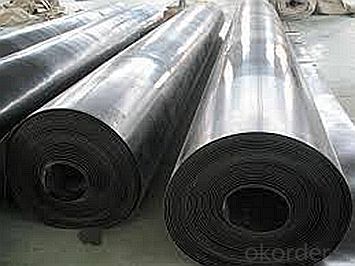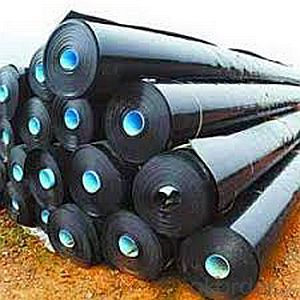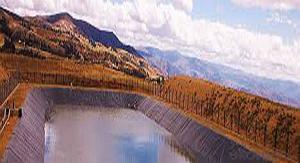Linear Low-density Polyethylene Geomembrane for Radioactive or Hazardous Waste Liquid
- Loading Port:
- China main port
- Payment Terms:
- TT OR LC
- Min Order Qty:
- 1000 m²
- Supply Capability:
- 1000000 m²/month
OKorder Service Pledge
OKorder Financial Service
You Might Also Like
Item specifice


Specifications
professional,satisfied service , the most competitive price , the best product ,do as your requirement
Features:
1.It can effectively make the concentrated stress diffuse, transfer or decompound, and prevent the soil mass against the destruction of outside force.
2.It can prevent the mixture of sandstone, soil mass and concrete of upper and lower layers.
3.Its mesh is hard to jam by virtue of the compliancy and motility of the reticulation formed by indefinite form fibrous tissue.
Packaging & Shipping
Packing: PLASTIC FILM INSIDE, AND WOVEN BAG OUTSIDE
Shipping: About 15 days after receipt the deposit
geotextile fabric
permeability,filtration,easy for construction
ISO and CE certificate
Good quality and competitive price
Our Service
Quality assurance
1.On a regular basis or as per your request,we entrust national testing agencies to conduct quality inspections
2. Strictly in accordance with the ISO9001-2008 international quality system standard,we monitor and manage the whole process throughout production,quality testing,and measurement to ensure product quality
3. For quality-related construction delay or substandard construction(except for damage or losses due to customer’s responsibility or irresistible natural disasters),we have refunding,replacement,and repair services.We will respond to customers’ feedbacks on quality issues within 24 hours.
After-sales service
1.In order to provide customers with comprehensive technical support,we will provide technical and other related information upon request in a timely manner.
2.In required,we will appoint specialized technicians to the construction site to give technical trainings to construction people,and offer technical guidance throughout the whole construction process.
3.For damage due to shipment and delivery,after we receive the complaint,we will check the issure through provided pictures and videos.If our responsibility is confirmed,we wil offer free replacement.
4.When the construction is completed,as your request,our technical staff may participate in the final acceptance.
FAQ:
Q: What kind of payments does jenor support?
A: T/T, L/C, Cash are accepted.
Q: Do you charge for the samples?
A: Accordeing to our company policy, the samples are free, we only charge the freight fee. And we will return the freight fee during the next order.
Q: Can you produce according to customers' design?
A: Sure, we are professional manufacturer, OEM and ODM are both welcome.
Q: Do you have other products?
A: Yes, please check the pictures:
- Q:What is geotextile? Its use
- Geotextile, also known as geotextile, it is made of synthetic fiber through acupuncture or weaving through the permeability of geosynthetics materials, geotextile, geotextile, geotextile, geotextile, The Finished cloth for the cloth, the general width of 4-6 meters, the length of 50-100 meters. Geotextile is divided into a woven geotextile and non-woven geotextile. Geotextile has excellent filtration, drainage, isolation, reinforcement, anti-seepage, protection, with light weight, high tensile strength, good permeability, high temperature, anti-freeze, anti-aging, corrosion resistance.
- Q:Artificial lake geotextile practices
- Library and slope with a composite geomembrane all laying, I specialize in the production and construction of geotextile materials
- Q:What are the specifications for geotextiles in retaining wall construction?
- The specifications for geotextiles in retaining wall construction typically include requirements for strength, permeability, and durability. The geotextile should have sufficient tensile strength to withstand the forces exerted by the retained soil, as well as the ability to allow water to pass through, preventing hydrostatic pressure buildup. It should also possess high puncture resistance and UV stability to ensure long-term performance in outdoor environments. Additionally, the specifications may outline requirements for the geotextile's weight, thickness, and installation methods to ensure proper functionality and compatibility with the specific retaining wall design.
- Q:Can geotextiles be used in underground gas storage projects?
- Yes, geotextiles can be used in underground gas storage projects. Geotextiles are commonly used in these projects to provide separation, filtration, and drainage functions. They help to prevent soil erosion, control water flow, and provide stability to the project. Additionally, geotextiles can enhance the gas storage system's efficiency by improving the overall performance and integrity of the underground structure.
- Q:How do geotextiles contribute to sustainable drainage systems?
- Geotextiles contribute to sustainable drainage systems by effectively managing stormwater runoff. They act as filters, allowing water to pass through while retaining sediment and pollutants. This helps to reduce the risk of flooding, erosion, and contamination of water bodies. Additionally, geotextiles promote infiltration of water into the ground, replenishing groundwater supplies and reducing the burden on traditional drainage systems. Overall, geotextiles play a vital role in ensuring sustainable and environmentally friendly drainage systems.
- Q:What are the different geotextile installation guidelines?
- There are several different geotextile installation guidelines that vary depending on the specific project and goals. Some common guidelines include ensuring proper site preparation, including clearing and grading the area, as well as removing any debris or vegetation. It is important to properly measure and cut the geotextile to fit the designated area, allowing for overlap and securing the edges. Additionally, proper anchoring methods should be used to prevent movement or displacement of the geotextile. Finally, regular inspection and maintenance should be conducted to ensure the geotextile is functioning as intended.
- Q:What are the different factors to consider for geotextile selection in agricultural applications?
- When selecting geotextiles for agricultural applications, several factors need to be considered. These factors include the type and level of soil erosion, the desired drainage and filtration requirements, the expected load and stress levels on the geotextile, the potential for chemical exposure, the climate and weather conditions, and the longevity and durability needed for the specific agricultural application.
- Q:Can geotextiles be used in agricultural drainage systems?
- Yes, geotextiles can be used in agricultural drainage systems. Geotextiles are permeable fabrics that can be installed to improve soil drainage by allowing water to pass through while preventing soil erosion. They can be used as a filter around drainage pipes to prevent soil particles from clogging the system, thus enhancing the effectiveness and longevity of the agricultural drainage system.
- Q:Can geotextiles be used for erosion control in riverbanks?
- Yes, geotextiles can be used for erosion control in riverbanks. They are often used as a protective barrier to prevent soil erosion by reinforcing the stability of the riverbank and allowing water to flow through while retaining the soil in place.
1. Manufacturer Overview |
|
|---|---|
| Location | |
| Year Established | |
| Annual Output Value | |
| Main Markets | |
| Company Certifications | |
2. Manufacturer Certificates |
|
|---|---|
| a) Certification Name | |
| Range | |
| Reference | |
| Validity Period | |
3. Manufacturer Capability |
|
|---|---|
| a)Trade Capacity | |
| Nearest Port | |
| Export Percentage | |
| No.of Employees in Trade Department | |
| Language Spoken: | |
| b)Factory Information | |
| Factory Size: | |
| No. of Production Lines | |
| Contract Manufacturing | |
| Product Price Range | |
Send your message to us
Linear Low-density Polyethylene Geomembrane for Radioactive or Hazardous Waste Liquid
- Loading Port:
- China main port
- Payment Terms:
- TT OR LC
- Min Order Qty:
- 1000 m²
- Supply Capability:
- 1000000 m²/month
OKorder Service Pledge
OKorder Financial Service
Similar products
New products
Hot products
Related keywords
































